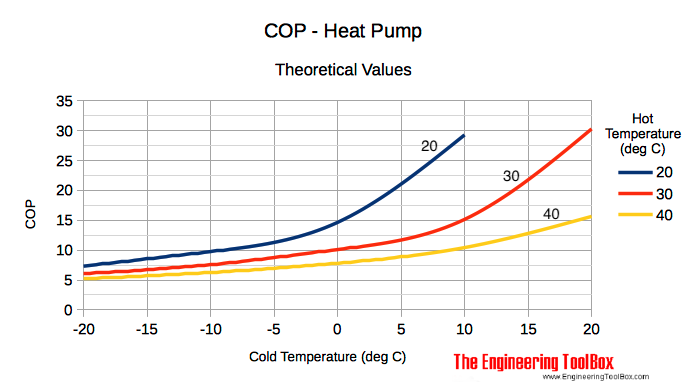Heat pumps move thermal energy from outside to inside, and in reverse when cooling.
A heat pump outputs cop kilowatt hours of thermal energy for space and hot water heating for every 1 kilowatt hour of electrical energy it consumes. The great attraction of heat pumps is that cop is usually much greater than 1. In other words, they output more energy heat energy than is input as electrical energy. This much more efficient than electrical heaters (cop is 1) or oil/gas boilers (cop typically between 0.5 and 0.95).

In theory cop can be large (see above) but is usually between 2 and 6, influenced mainly by:
- engineering limitations;
- the temperate and climate where your home is located;
- the number, efficiency, size and condition of radiators in your home;
- the diameter and length of the central heating plumbing connecting the heat pump to your radiators;
- how well insulated your home is;
- the flow capacity of your central heating pipes.
To describe your heat pump:
- use the “include” flag to include it;
- give an accurate average for cop over a year: scop (“seasonal coefficient of performance”) in “scop”. To obtain this reliably, ask a qualified installer to conduct a heat loss survey on your home and include (and preferably guarantee) the scop figure as part of its quotation;
- in “power” include the maximum heat power output for your heatpump “output_kw”, and its background power consumption “background_w” when not running;
- in “cost” include in “gbp” the initial costs (including necessary preparatory works, heat pump installation, radiator resizings, buffer tank if fitted), and annual costs (e.g. maintenance) in “gbp_per_year”.
"heat_pump": {
"include": true,
"scop": 4.0,
"power": {
"output_kw": 10.0,
"background_w": 20
},
"cost": {
"gbp": {
"install": 15000.0,
"grant": -7500
},
"gbp_per_year": {
"maintenance": 250.0
}
},
"design": {
"internal_temp_max_c" : 24.0,
"outside_temp_min_c" : -3.0,
"cops": {
"0": 5.1,
"5": 5.0,
"10": 4.9,
"20": 4.5,
"30": 4.0,
"40": 3.0,
"50": 2.0,
"60": 1.5,
"70": 1.2,
"80": 1.1,
"90": 1.0,
"100": 0.95
}
}
},The optional “design” tag fine tunes heat pump performance:
- “internal_temp_max_c” is the maximum room temperature that can be reached when the outside temperature is at its lowest, see below;
- “outside_temp_min_c” is the lowest outside temperature at which the heat pump can maintain “internal_temp_max_c”;
- “cops” is how cop varies with temperature expressed as an array of temperature – cop values. These are sometimes included in heat pump datasheets but accuracy is not critical and it can be omitted, especially if you know “scop”.
Leave a Reply